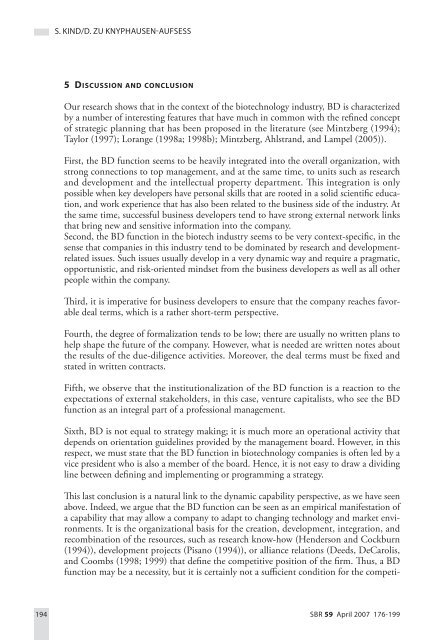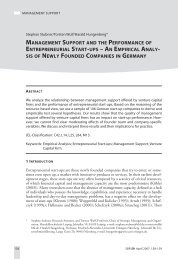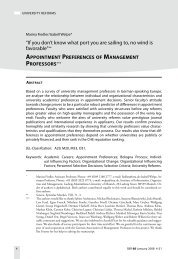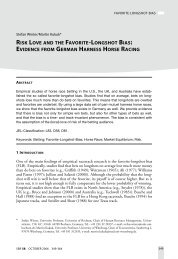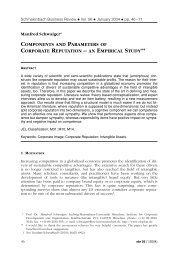“business development”? − the case of biotechnology - sbr ...
“business development”? − the case of biotechnology - sbr ...
“business development”? − the case of biotechnology - sbr ...
Create successful ePaper yourself
Turn your PDF publications into a flip-book with our unique Google optimized e-Paper software.
S. KIND/D. ZU KNYPHAUSEN-AUFSESS<br />
5 DISCUSSION AND CONCLUSION<br />
Our research shows that in <strong>the</strong> context <strong>of</strong> <strong>the</strong> <strong>biotechnology</strong> industry, BD is characterized<br />
by a number <strong>of</strong> interesting features that have much in common with <strong>the</strong> refi ned concept<br />
<strong>of</strong> strategic planning that has been proposed in <strong>the</strong> literature (see Mintzberg (1994);<br />
Taylor (1997); Lorange (1998a; 1998b); Mintzberg, Ahlstrand, and Lampel (2005)).<br />
First, <strong>the</strong> BD function seems to be heavily integrated into <strong>the</strong> overall organization, with<br />
strong connections to top management, and at <strong>the</strong> same time, to units such as research<br />
and development and <strong>the</strong> intellectual property department. Th is integration is only<br />
possible when key developers have personal skills that are rooted in a solid scientifi c education,<br />
and work experience that has also been related to <strong>the</strong> business side <strong>of</strong> <strong>the</strong> industry. At<br />
<strong>the</strong> same time, successful business developers tend to have strong external network links<br />
that bring new and sensitive information into <strong>the</strong> company.<br />
Second, <strong>the</strong> BD function in <strong>the</strong> biotech industry seems to be very context-specifi c, in <strong>the</strong><br />
sense that companies in this industry tend to be dominated by research and developmentrelated<br />
issues. Such issues usually develop in a very dynamic way and require a pragmatic,<br />
opportunistic, and risk-oriented mindset from <strong>the</strong> business developers as well as all o<strong>the</strong>r<br />
people within <strong>the</strong> company.<br />
Th ird, it is imperative for business developers to ensure that <strong>the</strong> company reaches favorable<br />
deal terms, which is a ra<strong>the</strong>r short-term perspective.<br />
Fourth, <strong>the</strong> degree <strong>of</strong> formalization tends to be low; <strong>the</strong>re are usually no written plans to<br />
help shape <strong>the</strong> future <strong>of</strong> <strong>the</strong> company. However, what is needed are written notes about<br />
<strong>the</strong> results <strong>of</strong> <strong>the</strong> due-diligence activities. Moreover, <strong>the</strong> deal terms must be fi xed and<br />
stated in written contracts.<br />
Fifth, we observe that <strong>the</strong> institutionalization <strong>of</strong> <strong>the</strong> BD function is a reaction to <strong>the</strong><br />
expectations <strong>of</strong> external stakeholders, in this <strong>case</strong>, venture capitalists, who see <strong>the</strong> BD<br />
function as an integral part <strong>of</strong> a pr<strong>of</strong>essional management.<br />
Sixth, BD is not equal to strategy making; it is much more an operational activity that<br />
depends on orientation guidelines provided by <strong>the</strong> management board. However, in this<br />
respect, we must state that <strong>the</strong> BD function in <strong>biotechnology</strong> companies is <strong>of</strong>ten led by a<br />
vice president who is also a member <strong>of</strong> <strong>the</strong> board. Hence, it is not easy to draw a dividing<br />
line between defi ning and implementing or programming a strategy.<br />
Th is last conclusion is a natural link to <strong>the</strong> dynamic capability perspective, as we have seen<br />
above. Indeed, we argue that <strong>the</strong> BD function can be seen as an empirical manifestation <strong>of</strong><br />
a capability that may allow a company to adapt to changing technology and market environments.<br />
It is <strong>the</strong> organizational basis for <strong>the</strong> creation, development, integration, and<br />
recombination <strong>of</strong> <strong>the</strong> resources, such as research know-how (Henderson and Cockburn<br />
(1994)), development projects (Pisano (1994)), or alliance relations (Deeds, DeCarolis,<br />
and Coombs (1998; 1999) that defi ne <strong>the</strong> competitive position <strong>of</strong> <strong>the</strong> fi rm. Th us, a BD<br />
function may be a necessity, but it is certainly not a suffi cient condition for <strong>the</strong> competi-<br />
194 SBR 59 April 2007 176-199


